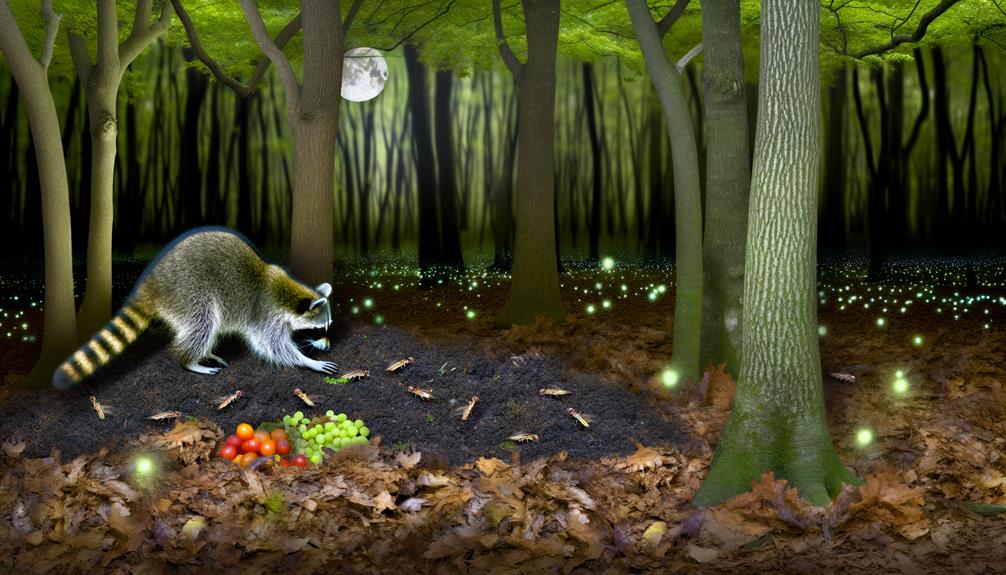How Do Raccoons Get Energy – A Guide to Their Sources
Raccoons obtain energy through an omnivorous diet, consuming a range of foods including fruits, nuts, insects, small mammals, and aquatic organisms. Their dietary habits are highly adaptable, changing with seasonal food availability and habitat.
Foraging techniques such as tactile searching and opportunistic feeding, combined with the ability to climb and occasionally use tools, optimize resource acquisition. Digestive adaptations and versatile enzyme production allow efficient extraction of nutrients.
Metabolic demands are met through strategies like torpor and fat storage, particularly in response to human activity altering foraging patterns. Explore further to uncover the intricate balance raccoons maintain for survival.

Key Takeaways
- Raccoons obtain energy from a diverse diet including fruits, nuts, insects, small mammals, and aquatic organisms.
- Seasonal food availability influences their dietary habits for optimal energy intake.
- Urban raccoons gain higher energy from human food waste and pet food.
- Efficient energy extraction is supported by versatile enzyme production in their digestive system.
- Energy conservation strategies include reduced activity, torpor, and fat storage.
Raccoon Dietary Habits
Raccoons, scientifically known as *Procyon lotor*, exhibit omnivorous dietary habits, consuming a diverse array of food sources including fruits, nuts, insects, small mammals, and aquatic organisms. Detailed field studies indicate that raccoons adapt their diet based on seasonal availability and habitat.
For example, in forested areas, they mainly consume acorns and berries, while in wetland regions, their diet shifts towards crayfish and amphibians. Isotope analysis of raccoon tissues has confirmed their reliance on both plant and animal matter, ensuring a balanced intake of carbohydrates, proteins, and fats.
Their ability to exploit various food sources not only supports their energetic requirements but also highlights their ecological flexibility, contributing to their widespread distribution across North America.
Omnivorous Tendencies
Raccoons exhibit omnivorous tendencies that enable them to exploit a wide array of food resources, contributing to their energy intake. Their diet encompasses a diverse range of both plant and animal matter, which varies seasonally to include fruits, nuts, insects, and small vertebrates.
This adaptive feeding strategy is supported by observational data indicating changes in foraging behavior and dietary composition in response to seasonal availability of food sources.
Diet Diversity Explained
Although raccoons are primarily nocturnal, their omnivorous tendencies allow them to exploit a diverse array of food sources. This ranges from fruits and nuts to small mammals and insects, ensuring a well-balanced diet that supports their energy needs.
This dietary flexibility is essential for their survival and energy acquisition. Scientific observations highlight the following key components of their diet:
- Fruits and Berries: Rich in carbohydrates, providing immediate energy.
- Nuts and Seeds: High in fats and proteins, essential for sustained energy.
- Small Mammals: Source of protein and fats, vital for growth and repair.
- Insects and Worms: High in protein, aiding in muscle maintenance.
- Aquatic Life: Fish and amphibians, offering a rich nutrient profile.
This diet diversity underscores the raccoon's adaptive foraging strategy.
Seasonal Feeding Habits
Seasonal variations in food availability compel raccoons to adjust their feeding habits, leveraging their omnivorous tendencies to maximize energy intake throughout the year. During spring, they consume a higher proportion of insects and small vertebrates, providing necessary proteins and fats. In summer, raccoons shift towards fruits and berries, taking advantage of the season's abundance of carbohydrates. Autumn witnesses a focus on nuts and seeds, essential for fat deposition in preparation for winter. Winter's scarcity forces raccoons to rely on human waste and any accessible animal remains.
| Season | Primary Food Sources | Nutritional Focus |
|---|---|---|
| Spring | Insects, small vertebrates | Proteins, fats |
| Summer | Fruits, berries | Carbohydrates |
| Autumn | Nuts, seeds | Fat deposition |
| Winter | Human waste, animal remains | Survival energy |
This adaptive strategy ensures raccoons maintain peak energy reserves year-round.
Foraging Techniques
In their quest for sustenance, Procyon lotor employ a diverse array of foraging techniques, leveraging their dexterous forepaws and keen sense of touch to locate and extract food from various environments. Raccoons exhibit remarkable adaptability in their foraging strategies, optimizing energy intake through various methods:
- Tactile Foraging: Utilizing their highly sensitive forepaws to detect and seize prey in aquatic and terrestrial settings.
- Opportunistic Feeding: Scavenging human refuse and other easily accessible food sources.
- Nocturnal Activity: Foraging primarily at night to avoid predators and reduce competition.
- Climbing Ability: Accessing arboreal food sources like bird eggs and fruits.
- Tool Use: Occasionally manipulating objects to access otherwise unreachable foods.
These techniques underscore the raccoons' ecological versatility and their proficiency in maximizing energy acquisition.
Seasonal Food Sources
Throughout the year, raccoons (Procyon lotor) strategically adjust their diet to exploit seasonally abundant food sources, thereby optimizing their energy intake and ensuring survival across varying environmental conditions.
During spring and summer, they primarily consume a diverse array of fruits, insects, and small vertebrates, capitalizing on the high availability of these protein and carbohydrate-rich resources.
As autumn approaches, raccoons shift to consuming nuts and seeds, which are calorically dense and essential for fat storage, critical for winter dormancy.
Winter diets are more opportunistic, with raccoons scavenging for remaining nuts, carrion, and human refuse.
This adaptive foraging behavior, guided by resource availability and nutritional needs, underscores the species' ecological flexibility and resilience.
Urban Vs. Rural Diet
The dietary habits of raccoons exhibit significant variation between urban and rural environments, reflecting the distinct availability of food resources in these settings. Urban raccoons often exploit anthropogenic resources, leading to a diet high in human refuse and pet food, while rural raccoons rely more on natural foraging. Studies indicate urban raccoons have higher caloric intake, potentially leading to increased body mass and altered activity patterns.
Key differences include:
- Urban Diet:
- Human food waste
- Pet food
- Garden produce
- Rural Diet:
- Wild fruits and nuts
- Small mammals and birds
- Aquatic organisms
Understanding these dietary distinctions is essential for wildlife management practices aimed at mitigating human-wildlife conflicts and ensuring the wellbeing of raccoon populations in diverse habitats.
Role of Insects
Insects make up a significant component of the raccoon's diet, providing vital proteins and nutrients that are important for their energy metabolism and overall health. Studies have shown that raccoons consume a variety of insects, including beetles, crickets, and caterpillars, which are rich in amino acids and lipids. These nutrients are essential for maintaining cellular function and energy production.
Entomological surveys indicate that insects can comprise up to 40% of a raccoon's diet during peak foraging seasons. The enzymatic breakdown of chitin and other complex carbohydrates in insects further highlights the raccoon's ability to efficiently extract energy. Therefore, the inclusion of insects in their diet not only supports their metabolic needs but also enhances their adaptability to diverse environments.
Digestive Adaptations
Raccoons' ability to efficiently extract energy from their diverse diet, including insects, is greatly facilitated by their unique digestive adaptations. Their digestive system exhibits several specialized features that enhance nutrient absorption and energy extraction.
Observations highlight a relatively simple stomach paired with an elongated small intestine, optimizing the breakdown of complex molecules. Additionally, raccoons possess a highly adaptable liver that aids in detoxifying diverse food sources.
Moreover, their cecum, though small, is functional and supports the fermentation of fibrous plant material. These adaptations are crucial in ensuring raccoons can thrive on a varied diet.
- Adaptable liver: Enhances detoxification
- Elongated small intestine: Optimizes nutrient absorption
- Functional cecum: Aids in fermentation
- Simple stomach: Facilitates rapid digestion
- Versatile enzyme production: Supports diverse food processing
Metabolic Rate
The metabolic rate of raccoons plays a crucial role in their energy acquisition and utilization. Basal Metabolic Rate (BMR) is a fundamental metric, reflecting the minimum energy expenditure necessary for maintaining essential physiological functions at rest.
Additionally, various factors such as activity levels, ambient temperature, and nutritional intake notably influence their overall energy expenditure, shaping their survival strategies in diverse environmental contexts.
Basal Metabolic Rate
Understanding the basal metabolic rate (BMR) of raccoons provides crucial insights into their energy expenditure and overall physiological functions. BMR represents the minimum amount of energy required to maintain essential processes such as respiration, circulation, and thermoregulation in a resting state.
Detailed observations and scientific measurements reveal that raccoons have a BMR influenced by factors such as body mass, age, and ambient temperature. Research indicates that:
- Raccoons exhibit a BMR ranging from 1.3 to 2.0 kcal per gram per hour.
- Seasonal variations impact BMR due to fluctuations in food availability.
- Juvenile raccoons demonstrate higher BMR to support growth.
- BMR decreases with age, reflecting reduced metabolic demands.
- Environmental conditions significantly influence thermoregulatory energy needs.
These data-driven insights underscore the complexity of raccoon metabolism.
Energy Expenditure Factors
Although basal metabolic rate provides a foundation for understanding energy demands, various factors such as activity level, foraging behavior, and reproductive status further modulate the overall metabolic rate in raccoons.
Activity level, characterized by nocturnal and crepuscular behaviors, influences caloric expenditure to a great extent. Data suggests that raccoons increase their metabolic rate by up to 25% during active foraging. Foraging behavior, including the energy-intensive search for diverse food sources, further heightens this rate.
Reproductive status also plays an essential role; females exhibit increased energy demands during gestation and lactation phases. Studies indicate a 30-40% rise in metabolic rate in pregnant and nursing raccoons.
Understanding these factors is vital for wildlife management and conservation efforts aimed at raccoon populations.
Energy Conservation
Raccoons employ a variety of physiological and behavioral strategies to conserve energy, such as entering a state of torpor during colder months to reduce metabolic demands. This adaptive response minimizes energy expenditure by lowering body temperature and slowing metabolic processes.
Additionally, raccoons optimize their energy usage through the following mechanisms:
- Reduced Activity: Limiting movements during harsh weather conditions.
- Efficient Foraging: Selecting food sources that provide maximum caloric intake with minimal effort.
- Shelter Utilization: Using dens and natural shelters to maintain body heat.
- Fat Storage: Accumulating fat reserves during warmer months to sustain themselves during periods of food scarcity.
- Efficient Thermoregulation: Utilizing fur insulation and behavioral adaptations to maintain the best body temperature.
These strategies collectively enhance raccoons' energy efficiency, essential for their survival.
Impact of Human Activity
Human activity greatly influences raccoon behavior and energetic strategies through habitat alteration, food availability, and increased human-wildlife interactions.
Urbanization creates fragmented habitats, compelling raccoons (Procyon lotor) to adapt by exploiting anthropogenic food sources, such as garbage and pet food, as primary energy sources. Studies indicate urban raccoons exhibit altered foraging behaviors and increased nocturnality to avoid human encounters, thereby conserving energy.
Data shows raccoons in urban environments have higher caloric intake due to consistent access to human-provided food, potentially leading to higher body mass indices. However, reliance on human-derived sustenance poses risks, including nutritional imbalances and increased disease transmission, affecting raccoon population dynamics and health.
Understanding these impacts enables better wildlife management and conservation strategies.
Conclusion
The multifaceted dietary habits, foraging strategies, and seasonal adaptations of raccoons underscore their metabolic versatility and efficiency in energy acquisition and conservation. Urban environments introduce anthropogenic influences, notably altering dietary patterns and energy dynamics.
Digestive adaptations further facilitate nutrient absorption, optimizing metabolic rates. These findings elucidate the complex interplay between raccoons and their habitats, highlighting the impact of human activity on wildlife energy balance.
Future research should quantify these interactions to better understand ecological repercussions and inform conservation strategies.






